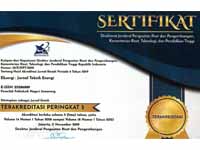PENGONTROLAN TEGANGAN PADA PROTON EXCHANGE MEMBRANE FUEL CELL (PEM-FC) MENGGUNAKAN PARTICLE SWARM OPTIMIZATION DAN PID
DOI:
https://doi.org/10.32497/eksergi.v18i1.3209Keywords:
Fuel cell, PSO, PID, Boost converterAbstract
Energi terbarukan telah menempati posisi salah satu yang dominan diteliti pada saat ini seiring dengan semakin menipisnya bahan bakar fosil. Salah satu energi terbarukan yang terus berkembang adalah fuel cell. Fuel cell merupakan peralatan konversi energi berdasarkan proses elektrokimia yang mengubah oksigen dan hidrogen menjadi air dan juga sekaligus menghasilkan panas dan energi listrik. Dikarenakan tegangan keluarn fuel cell yang rendah maka fuel cell perlu dirangkai secara seri dan parallel dan dinaikkan dengan boost converter sebelum dihubungkan dengan inverter dan beban AC. Penggunan metode PSO dalam menala nilai PID menjadi salah satu alternative yang dapat digunakan sehingga didapatkan sistem yang handal. Dari hasil simulasi, PSO-PID menghasilkan karakteristik sistem yang bagus seperti mengahasilkan overshoot yang rendah sebesar 211.3 Volt dan osilasi sedikit berjumlah 3 lonjakan. Sistem juga mencapai nilai steady state dengan cepat pada waktu 2.1 sekon an error sebesar 1 volt.References
C. J. Hatziadoniu, A. A. Lobo, F. Pourboghrat, and M. Daneshdoost, “A simplified dynamic model of grid-connected fuel-cell generators,” IEEE Trans. Power Delivery, vol. 17, no. 2, pp. 467”“473, Apr. 2002
C. Wang, Student Member, M.H.Nehrir, Senior Member, and H. Gao, Member.” Control of PEM Fuel Cell Distributed Generation Systems ”IEEE Transactionson Energy Conversion,vol.21,no.2, 2006
EG&G Technical Services, Inc. “Fuel Cell Handbook (Fifth Edition)”, U.S. Department of Energy, West Virginia, October 2000
El-Khattam, W., Salama M.M.A., “Distributed Generation Technologies, Definitions and Benefits”, Elsevier Electric Power Systems Research 71, pp. 119”“128, Canada, January, 2004
Fuel Cell Hand Book, 5th edition (2000). EG & G Services Parsons, Inc. Science Application International Corporation.
Hala Rslan, Mahrous Ahmed, Mohamed Orabi, Mohamed Youssef, “Development of Grid Connected Power Conditioner System Compatible with Fuel Cell Applications”, IEEE International Symposium on Power Electronics for Distributed Generation Systems, pp. 935-941,Canada, October, 2010
Jong-Soo Kim, Gyu-Yeong Choe, Byoung-Kuk Lee, Jae-Sun Shim, “Advanced Interchangeable Dynamic Simulation Model for the Optimal Design of a Fuel Cell Power Conditioning System”, Journal of Electrical Engineering & Technology Vol. 5, pp. 561-570, Korea, July, 2010
Lasseter, R. Tomsovic, K., Piagi, P., “Scenarios for Distributed Technology Applications with Steady State and Dynamic Models of Loads and Micro-Sources”, CERTS Report, 2000
Ma Su Su Hlaing, “Design of a Low Loss Inverter for Fuel Cell Application”, SIM University, May, 2010
Pratama, A., “Optimalisasi Sel Surya Menggunakan Maximum Power Point Tracker Sebagai Catu Daya Base Transceiver Station”, Teknik Elektro ITS, Surabaya, Agustus, 2010.
Perdana, P., & Saputra, S. (2000). Perbandingan Metode Bat Algorithm Dalam Tuning Optimal Parameter Pss Di Single Machine Infinite Bus ( SMIB ). 3(2), 123”“129. https://doi.org/10.32493/epic.v3i2.7624
Rahmawan, A., Budiman, A. H., & Hermawan, F. (2018). Disain sistem kontrol dan operasi untuk proton exchange membrane. Jurnal Energi Dan Lingkungan, 14(2), 75”“80.
RashidM.H,“PowerElectronics Handbook”,AcademicPress, 2001.
Surya, P. P., Irawan, D., & Zuhri, M. (2018). Review and comparison of DC-DC converters for maximum power point tracking system in standalone photovoltaic (PV) module. Proceeding - ICAMIMIA 2017: International Conference on Advanced Mechatronics, Intelligent Manufacture, and Industrial Automation, 242”“247. https://doi.org/10.1109/ICAMIMIA.2017.8387595
Yong Wang, Xu Cai, “DC Link Voltage Optimized Control for Efficient Residential Fuel Cell Converter”, Elsevier Electrical Power and Energy Systems 32,pp.1031”“1036,China,February, 2010
Downloads
Published
Issue
Section
License
Authors who publish with this journal agree to the following terms:Authors retain copyright and grant the journal right of first publication with the work simultaneously licensed under a Creative Commons Attribution License that allows others to share the work with an acknowledgement of the work's authorship and initial publication in this journal.
Authors are able to enter into separate, additional contractual arrangements for the non-exclusive distribution of the journal's published version of the work (e.g., post it to an institutional repository or publish it in a book), with an acknowledgement of its initial publication in this journal.
Authors are permitted and encouraged to post their work online (e.g., in institutional repositories or on their website) prior to and during the submission process, as it can lead to productive exchanges, as well as earlier and greater citation of published work (See The Effect of Open Access).






